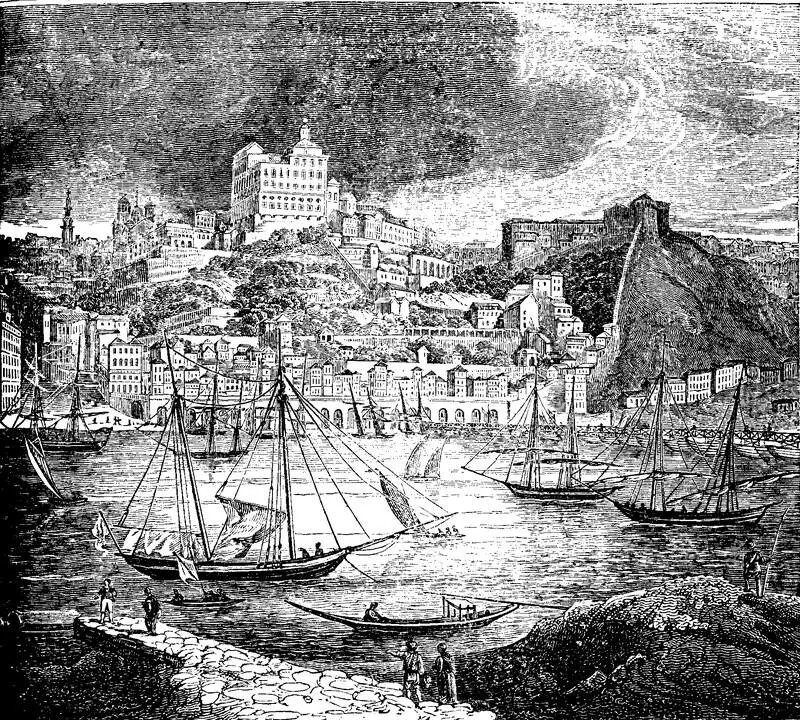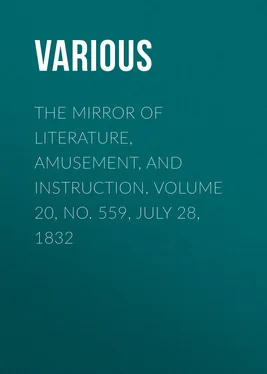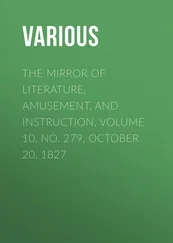Various - The Mirror of Literature, Amusement, and Instruction. Volume 20, No. 559, July 28, 1832
Здесь есть возможность читать онлайн «Various - The Mirror of Literature, Amusement, and Instruction. Volume 20, No. 559, July 28, 1832» — ознакомительный отрывок электронной книги совершенно бесплатно, а после прочтения отрывка купить полную версию. В некоторых случаях можно слушать аудио, скачать через торрент в формате fb2 и присутствует краткое содержание. Жанр: foreign_antique, periodic, Развлечения, foreign_edu, на английском языке. Описание произведения, (предисловие) а так же отзывы посетителей доступны на портале библиотеки ЛибКат.
- Название:The Mirror of Literature, Amusement, and Instruction. Volume 20, No. 559, July 28, 1832
- Автор:
- Жанр:
- Год:неизвестен
- ISBN:нет данных
- Рейтинг книги:3 / 5. Голосов: 1
-
Избранное:Добавить в избранное
- Отзывы:
-
Ваша оценка:
- 60
- 1
- 2
- 3
- 4
- 5
The Mirror of Literature, Amusement, and Instruction. Volume 20, No. 559, July 28, 1832: краткое содержание, описание и аннотация
Предлагаем к чтению аннотацию, описание, краткое содержание или предисловие (зависит от того, что написал сам автор книги «The Mirror of Literature, Amusement, and Instruction. Volume 20, No. 559, July 28, 1832»). Если вы не нашли необходимую информацию о книге — напишите в комментариях, мы постараемся отыскать её.
The Mirror of Literature, Amusement, and Instruction. Volume 20, No. 559, July 28, 1832 — читать онлайн ознакомительный отрывок
Ниже представлен текст книги, разбитый по страницам. Система сохранения места последней прочитанной страницы, позволяет с удобством читать онлайн бесплатно книгу «The Mirror of Literature, Amusement, and Instruction. Volume 20, No. 559, July 28, 1832», без необходимости каждый раз заново искать на чём Вы остановились. Поставьте закладку, и сможете в любой момент перейти на страницу, на которой закончили чтение.
Интервал:
Закладка:
Various
The Mirror of Literature, Amusement, and Instruction / Volume 20, No. 559, July 28, 1832
OPORTO

OPORTO.
Persons who are looking for "news from the seat of war" will probably hail the timely appearance of this Engraving, and regard it as folks sitting at a play do a drop-scene between the acts. The reader knows our pacific politics: we are of the pen, not of the sword; but we cannot be indifferent to a great political result, when
Old men, and beldams, in the streets
Do prophesy upon it.
Oporto is a place of great commercial as well as political consideration. Thousands of Englishmen have a grateful recollection of the former importance upon their very lips. Its situation is one of great natural beauty. It is the largest city in Portugal, Lisbon excepted. It has been commonly said to owe its origin to the Romans; 1 1 At Coimbra, about two days' journey from Oporto, is a Roman bridge and aqueduct, nearly entire.
but it appears, from the best authors, to have been founded about A.D. 417 by the Suevi, who had established themselves in Braga and other parts of ancient Galicia, but who were driven by the Alani to the banks of the Douro, where they fortified themselves on the steep hill now occupied by the cathedral and the bishop's palace, and which is still distinguished by the appellation of the Cidade de Antiga.
The city occupies the north bank of the Douro, (anciently Durius ,) about five miles from the mouth of the river, and the Atlantic Ocean. The approach from thence to Oporto is remarkably beautiful. The dangers of the bar, across the mouth of the river, once passed, 2 2 The dangerous passage across the bar of the Douro, and its shifting sands, are well known. The care and skill required to navigate a vessel with safety into the Douro, even during the summer, may give an idea of what the perils of this dangerous bar must be during the winter months; when the coast is exposed to the unbridled fury of the westerly winds, and to the full force of the Atlantic waves.— Portugal Illustrated, by the Rev. W. Kinsey, B.D.
a succession of interesting objects present themselves on both sides, as we ascend towards the city. The little town of St. Joao da Foz stands on the north bank, close to the sea, and is the favourite resort of the wealthier inhabitants of Oporto during the violent heat of the summer. The river, immediately within the bar, expands into the appearance of a lake. A little higher up it is narrowed by two abrupt hills. That on the right terminates in a precipice of bright hard sandstone, descending so steeply to the water's edge, that but lately a road has been made from Oporto along the bank of the river, to St. Joao da Foz, by blasting and hewing down a sufficient portion of the rock. This height, from its precipitous sides, is called the Monte d'Arabida, and forms the western boundary of a lovely valley, opening upon the Douro, covered with the Quintas, or villas, of the wealthier inhabitants of the adjoining city. Most of the Quintas at the mouth of the river command delightful prospects of the Atlantic Ocean, and the splendid effects produced on these scenes at sunset, in this glowing climate, are almost indescribable. Some idea of its beauty may be formed by reference to Colonel Batty's view from this point. 3 3 See Select Views of Oporto. By Lieut. Col. Batty, F.R.S., the accuracy of which may be said to extend as far as pictorial art can succeed in conveying foreign objects to our firesides. We are indebted for our Engraving to this valuable work.
The appearance of the Douro, with its numerous shipping, and the variety of interesting objects scattered on its cheerful banks, render this one of the most pleasing scenes in the circle of Oporto.
To economize time and space we must quit this enchanting spot. Gondolas, like those at Venice, are used on the river, but will not suffice for our celerity. We must reach at once the point of our Engraving. The view is taken from Villa Nova, an important suburb of Oporto, on the opposite bank of the river. The city may be divided into the high and the low town. It contains, in a civil sense, five wards, or bairros , of which the Sé, or cathedral hill, and the Vittoria, or height opposite to the Sé, (and crowned by a church, which was founded in commemoration of a celebrated battle fought on the spot with the Moors, which terminated in their defeat and expulsion from the place,) form the town properly called Oporto; and it is possible still to trace the remains of the old wall, which formerly surrounded and defended the place. The three other quarters, San Idelfonso, Miragaya, and Villa Nova, are open. The latter is connected with the principal town by a bridge of boats, which is so badly constructed as to be scarcely able to sustain the violent power of the river when swelled by winter torrents. The Douro, like the Rhine and the Rhone, and all other rivers which flow through a rocky and often confined channel, commits at certain seasons the greatest ravages; and property to a considerable amount is annually lost at Oporto, by the irresistible force with which the river pours down and carries every thing before it. A bridge of granite has been long talked of to connect Villa Nova and Oporto, but the funds are not yet forthcoming, and the expense will be considerable.
The Engraving represents the most ancient part of the city of Oporto. We are here directly fronting the bishop's palace, which, with the Sé, or Cathedral, 4 4 Here is the altar of wrought silver, which was fortunately rescued from the hands of the French, when in possession of Oporto.
and buildings, to the left, occupy the crest of the hill. Further left is the steeple of the church dos Clerigos, said to be the loftiest in Portugal after that of Mafra. This tower is visible from the sea at a distance of ten leagues, and serves as an important landmark for ships steering to the mouth of the Douro. It was erected in the year 1748, and is built entirely of the finest masonry, an art in which the Portuguese are almost unrivalled. On the summit of the hill to the right, touching the old walls and towers, is the convent of Santa Clara. Immediately below the Cathedral, the rocky steep has been cut into terraces, and laid out in gardens. The river is bordered by the old city wall. A noble street, the Rua Nova de St. Joao, is seen opening upon the quay on the left. Part of the bridge of boats appears on the right: it was first constructed in the year 1806, destroyed in 1809, but re-established in 1815. It was the scene of dreadful slaughter at the time the city was given up to pillage by the French. Some of the boats forming it had been destroyed, and many of the wretched inhabitants crowding to the bridge, in hopes of escaping from the enemy's sword were urged on by the affrighted multitude into the rapid stream, and thus perished. On the river, to the right and left, is seen a Portuguese coasting vessel, called Hyate; in the centre is a wine-boat of the Douro, with a raised platform for the steersman. The foreground of the view is the shore of Villa Nova, adjoining the quay. The chief article of export is wine; 5 5 The annual average quantity of wine exported from Oporto to Great Britain, was in the ten years, 1813-1822, 24,364 pipes, and to all other parts of the world only 1,094 pipes per annum. The quantity since 1822 has not materially altered.— See a Communication to vol. xv. of the Mirror , p. 118.
and here is the grand depôt for this commodity, which is stowed in long, low buildings, called lodges.
Интервал:
Закладка:
Похожие книги на «The Mirror of Literature, Amusement, and Instruction. Volume 20, No. 559, July 28, 1832»
Представляем Вашему вниманию похожие книги на «The Mirror of Literature, Amusement, and Instruction. Volume 20, No. 559, July 28, 1832» списком для выбора. Мы отобрали схожую по названию и смыслу литературу в надежде предоставить читателям больше вариантов отыскать новые, интересные, ещё непрочитанные произведения.
Обсуждение, отзывы о книге «The Mirror of Literature, Amusement, and Instruction. Volume 20, No. 559, July 28, 1832» и просто собственные мнения читателей. Оставьте ваши комментарии, напишите, что Вы думаете о произведении, его смысле или главных героях. Укажите что конкретно понравилось, а что нет, и почему Вы так считаете.












